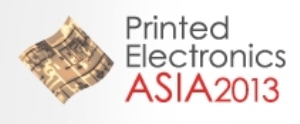May 8 2013
Variously called Printed, Flexible or Organic Electronics, it is one of the fastest growing technologies in the world. It is of vital interest to industries as diverse as consumer goods, healthcare, mobility, electronics, media and architecture.

For example, it is seen in the interior overhead cluster in the new Ford Fusion electric cars and in Estee Lauder electronic skin patches for cosmetics, in Duracell batteries and new toys. Leading analysts IDTechEx find that the total market for printed, flexible and organic electronics will rocket from $16 Billion in 2013 to $77 Billion in 2023. The majority of that is OLEDs (organic and soon to be printed) and conductive ink used for a wide range of applications of printed electronics. This market will experience 14.5% CAGR over the next 5 years.
The unique event "Printed Electronics Asia" (www.PrintedElectronicsAsia.com) being held July 9-10, 2013 in Tokyo will reveal radical changes in this subject. For some years, flexible, meaning rollable electronics and electrics has been the primary focus. Something more - stretchable electronics - is needed if most potential applications are to be realised. That includes photovoltaics over the 3D body of a car and smart skin patches on humans and other animals. At the event, Dr Tsuyoshi Sekitani, assistant professor at the University of Tokyo, will therefore speak on "Printed Ultraflexible Organic Circuits for BioMedical Sensors".
Paper electronics is coming to the fore. Unsuccessful printed transistor technologies are giving way to new options such directly printing or transfer printing onto paper. That includes the ball-milled silicon transistors of the University of Cape Town and its spin-off PST Sensors in South Africa which will reveal, "Printed Silicon in Electronics" at the event. PragmatIC Printing of the United Kingdom will report its "Commercial Applications of Printed Logic" notably in consumer packaged goods, also the focus of Ynvisible in Portugal with its talk on "Printed interactive Graphics for Consumer Packaged Goods Companies".
The Japan Chemical Innovation Institute will discuss "Reverse Offset Printing: Promising Tool for Printed TFTs", Delft University of Technology in the Netherlands will announce "Flexible Single Grain Si TFTs", there will be a report on "Organic Thin Film Transistors at AIST" which is Japan's National Institute of Science and Technology". Dr Beng Ong, famous for his work on the subject in Xerox Canada then Singapore will explain, from Hong Kong Baptist University, "High Performance Semiconductors for Printed Electronics - a Decade of Progress". It is interesting that, on recent assessments by the US National Renewable Energy Laboratory, organic photovoltaics - closely related to the semiconductors in transistors - now has efficiency better than Dye Sensitised Solar Cells (DSSC), which it has overtaken. Printed and other thin film photovoltaics receive great attention this year.
Most of the key photovoltaic, display and sensor devices need transparent conductive films yet the ubiquitous Indium Tin Oxide (ITO) is subject to price hikes and is particularly expensive when patterned, printing being an unsuccessful option so far. It cracks when tightly rolled, so it will be useless for planned mobile phones with unrolling large displays and keyboards. This year, very different technologies head the list of potential alternatives. For example, hear about "Cambrios ClearOhm: Solution Coated and Printed Transparent Conductor for Printed Electronics" and Professor Dr Masaya Nogi of Osaka University on, "Transparent Silver Nanowire Electrodes for Photovoltaic Paper". Recent analysis by IDTechEx has determined that silver nanowires are one of the most promising new options for ITO replacement.
The uses and targeted uses of printed electronics and electrics are changing too. Displays and Radio Frequency Identification (RFID) were the emphasis and progress on these is being covered at the event but now Organic Light Emitting Display (OLED) lighting is close to commercial rollout as will be explained by the giants Panasonic and Konica Minolta with research presented by Hong Kong Baptist University. Cynora of Germany covers innovative OLED materials. Once again, the organisers, the analysts IDTechEx, fly in best-in-class speakers from all over the world. For example Merck of Germany will report on its improved printed electronics materials. Professor Jin Jang of Kyung Hee University in Korea evaluates "Solution Processed Devices for Large Area Electronics".
The mobile phone of the future and the Internet of Things are vital applications of printed electronics. They feature in Professor Gyoujin Cho's "Fully Gravure Printed NFC Sensor tags for Wireless Diagnosis". We shall also hear The Federal Polytechnic School of Switzerland on "Recent Advances in Printing Smart Sensing RFID Labels" and Freescale USA on "The Role of Sensor Fusion in the Internet of Things". There are many other carefully selected, linked topics at this event, such as printing most of the electronics and power components in electric vehicles, structural components, smart skin, relevant uses of graphene and developments in supercapacitors and in manufacturing of printed electronic and electric circuits and power components. There will be awards and masterclasses are optional on the day before and the day after the two day conference and exhibition.
For full details on this event and to register, visit www.PrintedElectronicsAsia.com or contact Cara Harrington at [email protected].
About IDTechEx
IDTechEx guides your strategic business decisions through its Research and Events services, helping you profit from emerging technologies. IDTechEx Events provide an analytical, commercial outlook, taking into account market requirements, competitive technologies and development roadmaps. Attendees are presented with the full, diverse range of technologies - pushing knowledge depth in key fundamentals and expanding it in new related technologies; but the main thrust is always on end user needs and commercialization strategies. For more information see www.IDTechEx.com.